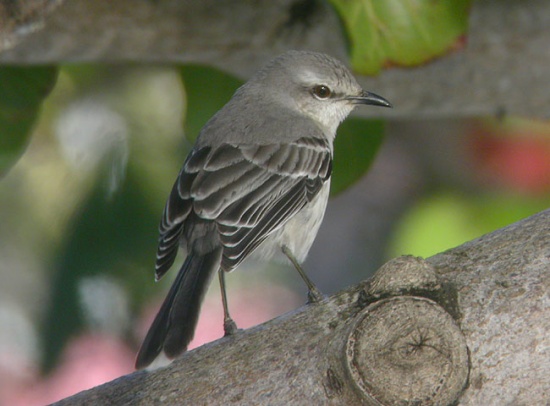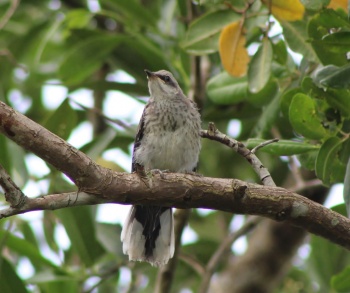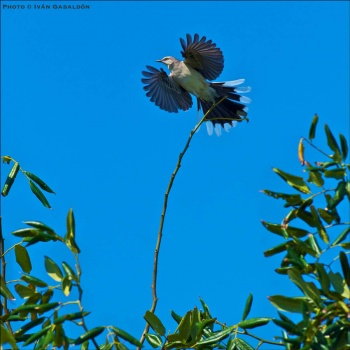- Mimus gilvus
Identification
Total length 23-26 cm (9-10 in). A medium-sized mockingbird with a long tail.
It is overall grey with whitish underparts. The wings are blackish with whitish edging often forming two narrow wing-bars. The tail is mainly blackish, but the outer rectrices are broadly white-tipped (best seen when the tail is spread or from below). The whitish eye-brow is border below by the dusky lores and faint post-ocular streak/spot.
Females are slightly smaller than males.
Juveniles resemble adults, but are generally browner and with dusky streaking to the flanks (some adults retain slight streaking to the lower flanks).
Variations
The numerous races vary mainly in size and plumage tone, e.g. blackness of wings and/or strength of white eye-brow.
Similar Species
In the limited area of overlap in southern Mexico, it can be separated from the very similar Northern Mockingbird by the lack of a whitish patch near the base of the primaries.
The voices of the Tropical and the Northern Mockingbird are virtually inseparable. In the coastal regions of Brazil the Tropical Mockingbird overlaps with the Chalk-browed Mockingbird, which is browner and has a stronger post-ocular streak/spot.
Distribution
It is widespread from southern Mexico and the Yucatán Peninsula, south through Central America, to northern South America (Colombia, Venezuela, far northern Brazil, far northern Ecuador and the Guianas), and coastal Brazil. It also occus in the Lesser Antilles, Trinidad & Tobago, San Andrés Island, (off E. Nicaragua) and Cozumel Island.
The population in Panama seems to have originated from escaped/released birds originating in Colombia.
Taxonomy
Hybrids between the closely related Tropical and Northern Mockingbird have been reported from Mexico.
Subspecies
This is a polytypic species, consisting of ten subspecies[1]:
- M. g. gracilis: Southern Mexico (eastern Oaxaca) to Guatemala, Honduras, El Salvador and western Nicaragua
- M. g. leucophaeus: Humid tropical south-eastern Mexico, Cozumel Island, Isla Mujeres and Belize
- M. g. antillarum: Martinique, St. Lucia, St. Vincent, the Grenadines and Grenada but seemingly has spread further north to Antigua and Barbuda
- M. g. tobagensis: Trinidad and Tobago
- M. g. rostratus: Netherlands Antilles and adjacent islands off northern coast of Venezuela
- M. g. tolimensis: southern Nicaragua south to western Ecuador and central Colombia; range has expanded both north and south out of Colombia since the 1990s
- M. g. melanopterus: Coastal northern Colombia to Venezuela, Guyana and extreme northern Brazil
- M. g. gilvus: French Guiana and Suriname
- M. g. antelius: Coastal eastern Brazil (Par to Rio de Janeiro)
- M. g. magnirostris: Isla San Andres (western Caribbean Sea)
It has been suggested that the subspecies magnirostris (from San Andrés Is.) and antelius (from coastal Brazil) should be regarded as separate species.
Habitat
It occurs in a wide range of open and semi-open habitats, including fields, scrub, savanna, farmland and parks. Often near humans. It avoids dense forest. Race antelius is restricted to restinga (a type of coastal scrub).
Behaviour
It is bold, aggressive and territorial.
Diet
Omnivorous. Has been recorded taking fruits, berries, insects and bird eggs.
Breeding
Typically lives in small groups, comprising a monogamous pair, and their offspring from earlier broods, which help raising new broods.
References
- Clements, J. F., T. S. Schulenberg, M. J. Iliff, T. A. Fredericks, J. A. Gerbracht, D. Lepage, S. M. Billerman, B. L. Sullivan, and C. L. Wood. 2022. The eBird/Clements checklist of Birds of the World: v2022. Downloaded from https://www.birds.cornell.edu/clementschecklist/download/
- Gill, F, D Donsker, and P Rasmussen (Eds). 2023. IOC World Bird List (v 13.2). Doi 10.14344/IOC.ML.13.2. http://www.worldbirdnames.org/
- Birdforum Member observations
Recommended Citation
- BirdForum Opus contributors. (2025) Tropical Mockingbird. In: BirdForum, the forum for wild birds and birding. Retrieved 15 May 2025 from https://www.birdforum.net/opus/Tropical_Mockingbird
External Links
GSearch checked for 2020 platform.1






